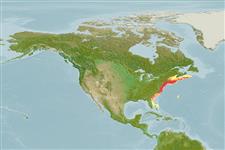| Native range |

|
| Paralichthys dentatus AquaMaps Data sources: GBIF OBIS |
Length at first maturity
Lm 28.0 range ? - ? cm
Human uses
Fisheries: commercial; gamefish: yes
Phylogenetic diversity index
(Ref. 82805)
PD50 = 0.5000 many relatives (e.g. carps) 0.5 - 2.0 few relatives (e.g. lungfishes)
Trophic Level
(Ref. 69278)
4.5 ±0.3 se; Based on diet studies.
Resilience
(Ref. 69278)
Medium, minimum population doubling time 1.4 - 4.4 years (K=0.77-0.84(?); assuming tm>=2; tmax=9)